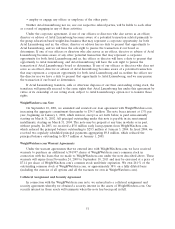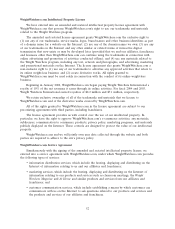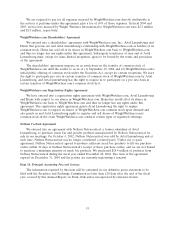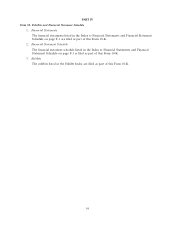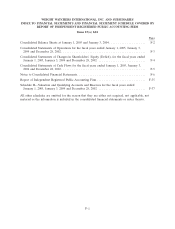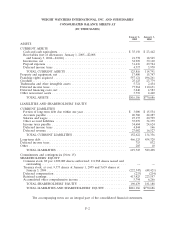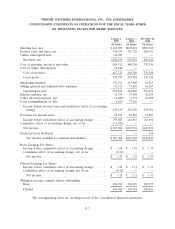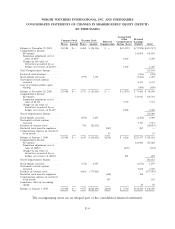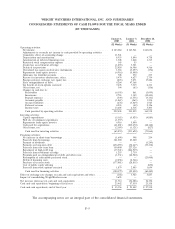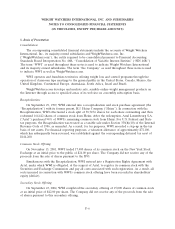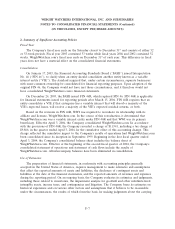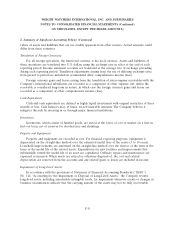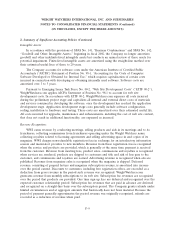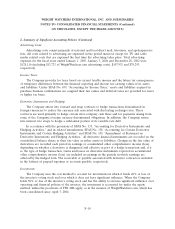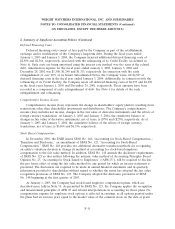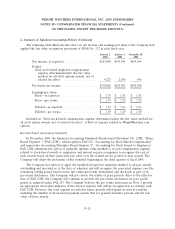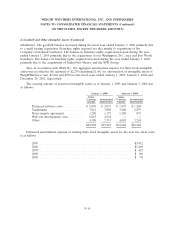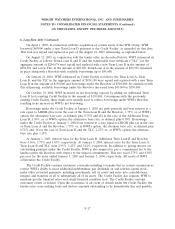WeightWatchers 2004 Annual Report Download - page 69
Download and view the complete annual report
Please find page 69 of the 2004 WeightWatchers annual report below. You can navigate through the pages in the report by either clicking on the pages listed below, or by using the keyword search tool below to find specific information within the annual report.WEIGHT WATCHERS INTERNATIONAL, INC. AND SUBSIDIARIES
NOTES TO CONSOLIDATED FINANCIAL STATEMENTS (Continued)
(IN THOUSANDS, EXCEPT PER SHARE AMOUNTS)
2. Summary of Significant Accounting Policies
Fiscal Year:
The Company’s fiscal year ends on the Saturday closest to December 31st and consists of either 52
or 53-week periods. Fiscal year 2003 contained 53 weeks while fiscal years 2004 and 2002 contained 52
weeks. WeightWatchers.com’s fiscal year ends on December 31st of each year. This difference in fiscal
years does not have a material effect on the consolidated financial statements.
Consolidation:
On January 17, 2003, the Financial Accounting Standards Board (‘‘FASB’’) issued Interpretation
No. 46 (‘‘FIN 46’’), to clarify when an entity should consolidate another entity known as a variable
interest entity (‘‘VIE’’). The standard required that, under certain circumstances, separate businesses
with some common ownership be consolidated for financial reporting purposes. Upon adoption of the
original FIN 46, the Company would not have met those circumstances, and it therefore would not
have consolidated WeightWatchers.com’s financial statements.
On December 24, 2003, the FASB issued FIN 46R, which replaced FIN 46. FIN 46R is applicable
for financial statements issued for reporting periods after March 15, 2004. FIN 46R requires that an
entity consolidate a VIE if that enterprise has a variable interest that will absorb a majority of the
VIE’s expected losses, will receive a majority of the VIE’s expected residual returns, or both.
Based on the revisions in FIN 46R, WWI was required to reevaluate its relationship with its
affiliate and licensee, WeightWatchers.com. In the course of this reevaluation, it determined that
WeightWatchers.com was a variable interest entity under FIN 46R and that WWI was its primary
beneficiary. Effective April 3, 2004, the Company consolidated WeightWatchers.com. In accordance
with the provisions of FIN 46R, the Company recorded a charge of $11,941, including a tax charge of
$9,866, in the quarter ended April 3, 2004 for the cumulative effect of this accounting change. This
charge reflected the cumulative impact to the Company’s results of operations had WeightWatchers.com
been consolidated since its inception in September 1999. Beginning in the first fiscal quarter ended
April 3, 2004, the Company’s consolidated balance sheet includes the balance sheet of
WeightWatchers.com. Effective at the beginning of the second fiscal quarter of 2004, the Company’s
consolidated statement of operations and statement of cash flows include the results of
WeightWatchers.com. All intercompany balances have been eliminated in consolidation.
Use of Estimates:
The preparation of financial statements, in conformity with accounting principles generally
accepted in the United States of America, requires management to make estimates and assumptions
that affect the reported amounts of assets and liabilities, the disclosure of contingent assets and
liabilities at the date of the financial statements, and the reported amounts of revenues and expenses
during the reporting period. On an ongoing basis, the Company evaluates its estimates and judgments,
including those related to inventories, the impairment analysis for goodwill and other indefinite-lived
intangible assets, income taxes, and contingencies and litigation. The Company bases its estimates on
historical experience and on various other factors and assumptions that it believes to be reasonable
under the circumstances, the results of which form the basis for making judgments about the carrying
F-7


